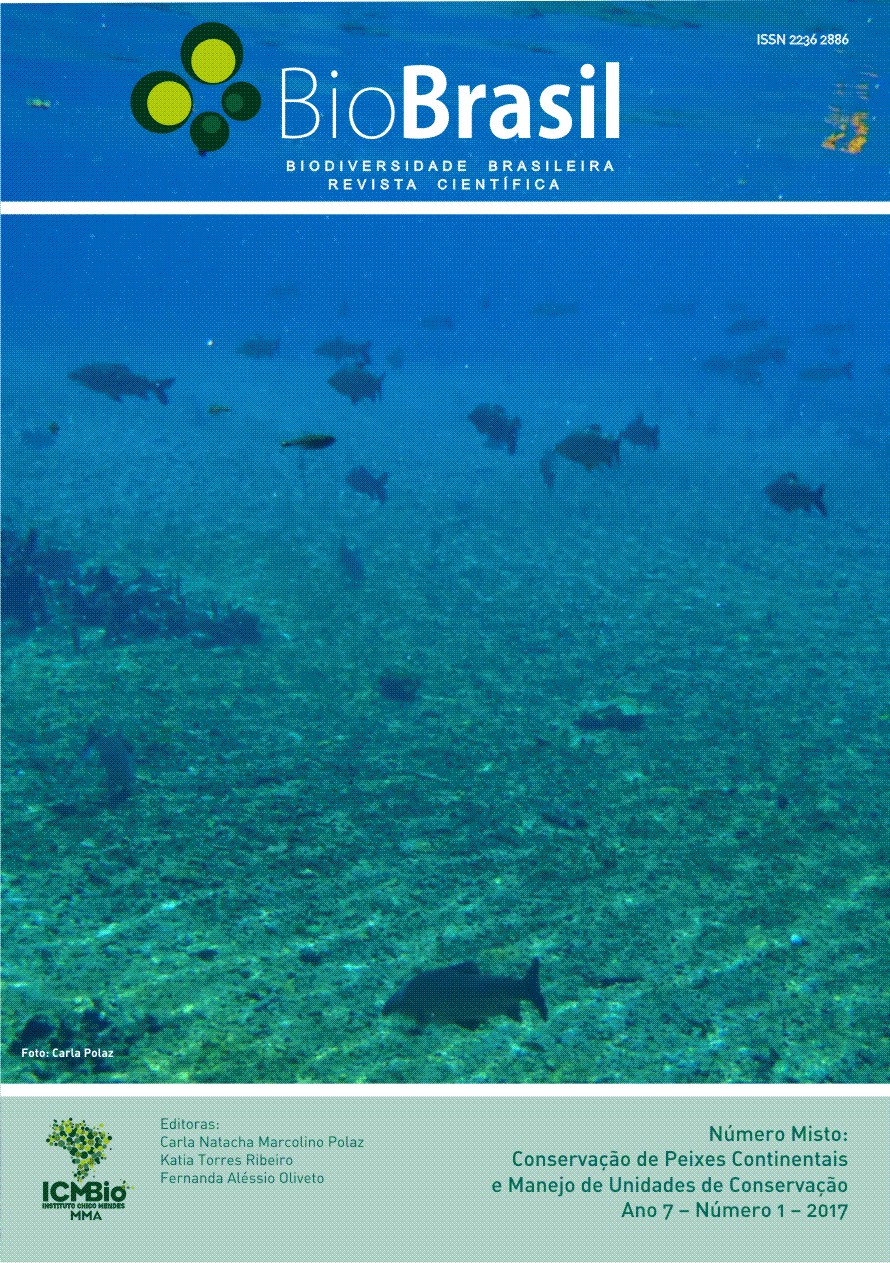The Amazon Protected Areas Program (ARPA): participation, local development, and governance in the Brazilian Amazon
DOI:
https://doi.org/10.37002/biodiversidadebrasileira.v7i1.641Keywords:
Governance, Brazilian protected areas, action plans, integration of communitiesAbstract
The management of Protected Areas (PAs) in Brazil has been slowly incorporated the concept of participative governance, promoting the involvement and participation of local populations. There is a direct relationship between governance and effective management of PAs in such way that conservation of territories with involvement of local communities brings benefits to the society for a very low cost. The Amazon Protected Areas Program (ARPA) is a program launched by the Brazilian government in 2002 that supports 59,2 million hectares of PAs, making it the most ambitious biodiversity conservation program in the world. The main objectives of the ARPA include to protecting representative samples of biodiversity, ecosystems and associated landscapes, as well as maintaining of the environmental services. Based on decentralized and participative management principles, the Program also supports local communities, developing and implementing strategies of sustainable use of natural resources. Particularly, the subcomponent “integration of communities” supports 23 action plans, based on social and environmental safeguards of World Bank. This study presents the results of 14 action plans, which have been monitored and evaluated over the past two years. Methodology included participative workshops with PAs managers, along with fieldwork research for accomplishing activities with local stakeholders. Moreover, action plans have been evaluated throughout progress reports, meetings acts, and other documents related to the implementation of the plans. Ten out of 14 action plans have presented significant advances in the sustainable management of natural resources, community organization, and income generation. We found that positive results include establishment of partnerships among different organizations (e.g. local organizations, NGOs, universities, and research institutes); empowerment of local communities and more participation of stakeholders in the councils of PAs; improvements of communication and knowledge interchanges between stakeholders, communities, and managers; and strengthening of institutional dialogue. The main challenges concerning the successful implementation of the action plans include lack of human resources, high staff turnover, and bureaucracy related to the financial resources execution. We conclude that local development can significantly contribute to the effective management and conservation of PAs.
References
Aleixo, J. 2011a. Memorial da luta pela Reserva Extrativista do Ituxi em Lábrea. Brasília: Instituto Internacional de Educação do Brasil – IEB, 82p.
Aleixo, J. (Org.). 2011b. Memorial da luta pela Reserva Extrativista do Médio Purus em Lábrea. Brasília: Instituto Internacional de Educação do Brasil – IEB, 82p.
Andrade, R.A. 2013. Preservar para Viver: a experiência da preservação de quelônios no rio Ituxi em Lábrea (AM). Brasília: Instituto Internacional de Educação do Brasil – IEB, 79p.
Araujo, A.M.R. 2010. Avaliação da implementação do Programa ARPA entre os anos 2003 e 2010. Available at: programaarpa.gov.br/wp-content/uploads/2014/08/avaliacao-fase-um1.pdf
Borrini-Feyerabend, G. & Hill, R. 2015. Governance for the conservation of nature. In: Worboys, G.L. et al. (Eds.). Protected Area Governance and Management. Canberra: ANU Press, pp. 169-206.
Borrini-Feyerabend, G.; Dudley, N.; Jaeger, T.; Lassen, B.; Broome, N.P.; Phillips, A. & Sandwith, T. 2013. Governance of Protected Areas: From understanding to action. Best Practice Protected Area Guidelines Series No. 20, Gland, Switzerland: IUCN. xvi + 124pp.
Brasil. 2004. Estudos da Amazônia: avaliação de vinte projetos PDA. Secretaria de Coordenação da Amazônia, Programa Piloto para a Proteção das Florestas Tropicais do Brasil, Subprograma Projetos Demonstrativos. Brasília: Ministério do Meio Ambiente, 134 p.
Calegare, M.G.A. & Higuchi, M.I.G. 2013. Significado de morar e viver numa Unidade de Conservação. In: Higuchi, M.I.G.; Freitas, C.C.F. & Higuchi, N. (Eds.). Morar e viver em Unidades de Conservação no Amazonas: considerações socioambientais para os planos de manejo. Manaus, p. 189-212.
Campos-Silva, J.V. & Peres, C.A. 2016. Community-based management induces rapid recovery of a highvalue tropical freshwater fishery. Scientific Reports 6: 1-13. Available at: http://www.nature.com/articles/ srep34745
Dovers, S.; Feary, S.; Martin, A.; McMillan, L.; Morgan, D. & Tollefson, M. 2015. Engagement and participation in protected area management: who, why, how and when?, in G. L. Worboys, M. Lockwood, A. Kothari, S. Feary and I. Pulsford (Eds). Protected Area Governance and Management, Canberra: ANU Press, pp. 413-440.
Guerra, R. & Ascher, P. (Orgs.). 2006. Estratégias e métodos de monitoramento em projetos de proteção das florestas tropicais brasileiras. Brasília: MMA, 214p.
ICMBio and WWF-Brasil 2012. Efetividade de Gestão das Unidades de Conservação Federais do Brasil. Available at: http://observatorio.wwf.org.br/site_media/upload/gestao/documentos/Rappam_ federal_2010.pdf.
Kahn, M. 2009. Subcomponente Participação Comunitária – Relatório resumido. Funbio. Available at: http://www.funbio.org.br/wp-content/uploads/2012/04/funbio_relatorio_anual_2009.pdf
Müller, E.; Appleton, M.R.; Ricci, G.; Valverde, A. & Reynolds, D. 2015. Capacity development, In: G. L. Worboys, M. Lockwood, A. Kothari, S. Feary and I. Pulsford (eds) Protected Area Governance and Management. Canberra: ANU Press, pp. 251-290.
Rodrigues, L. & Anciães, M. 2015. Verde Perto Educação. Manaus: Ed. INPA.
Scherl, L.M.; Wilson, A.; Wild, R.; Blockhus, R.; Franks, P., McNeely, J.A. & McShane, T.O. 2004. Can Protected Areas Contribute to Poverty Reduction? Opportunities and Limitations. Gland, Switzerland, and Cambridge, UK: IUCN, viii, 60p.
Szlafsztein, C.F. 2012. Development projects for small rural communities in the Brazilian Amazon region as potential strategies and practices of climate change adaptation. Mitigation and Adaptation Strategies for Global Change 19(2): 1-18.
Soares-Filho, B.S.; Moutinho, P.; Nepstad, D.; Anderson, A.; Rodrigues, H.; Garcia, R.; Dietzsch, L.; Merry, F.; Bowman, M.; Hissa, L.; Silvestrini, R. & Maretti, C. 2010. The role of Brazilian Amazon protected areas in climate change mitigation. Proceedings of the National Academy of Sciences 107(24), pp. 10821-10826.
WWF. 2016. Arpa For Life: Amazon Region Protected Area Phase III Report. Available at: http://assets. worldwildlife.org/publications/934/files/original/WWF_ARPA_2016_Report_R8_Reader_Sprds_8.26.16_ final_1_.pdf?1472492610
Downloads
Published
Issue
Section
License
Copyright (c) 2017 Os autores mantêm os direitos autorais de seus artigos sem restrições, concedendo ao editor direitos de publicação não exclusivos.

This work is licensed under a Creative Commons Attribution-NonCommercial-NoDerivatives 4.0 International License.
Os artigos estão licenciados sob uma licença Creative Commons Atribuição-NãoComercial-SemDerivações 4.0 Internacional (CC BY-NC-ND 4.0). O acesso é livre e gratuito para download e leitura, ou seja, é permitido copiar e redistribuir o material em qualquer mídia ou formato.





 v3-3-0-3-2-1-8-release.27
v3-3-0-3-2-1-8-release.27